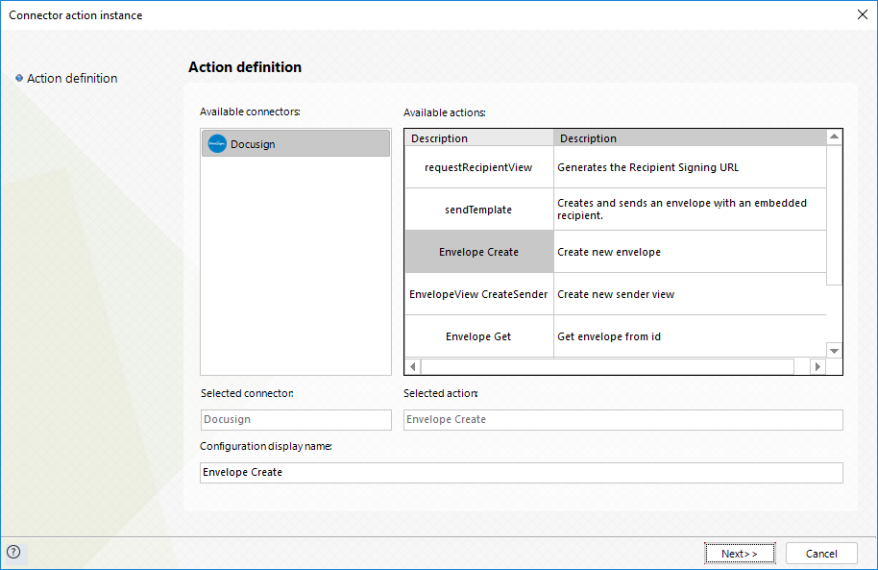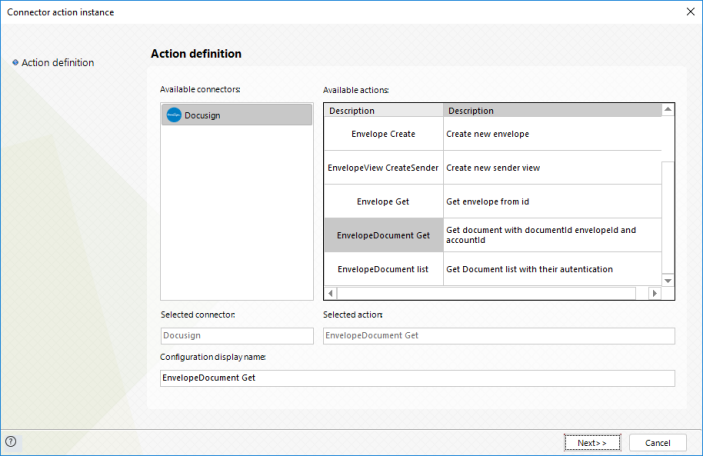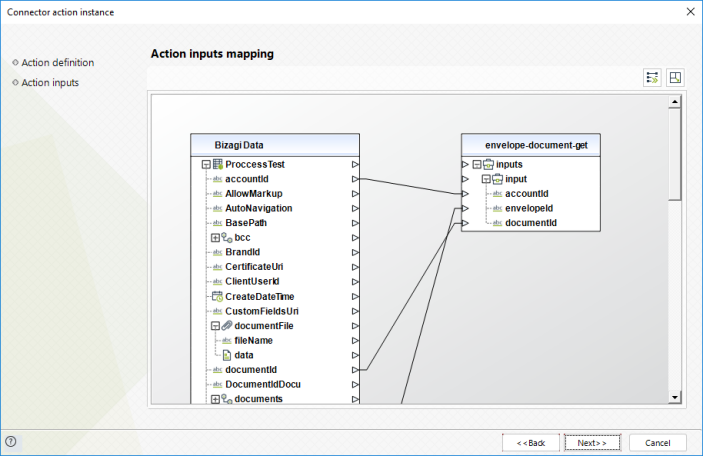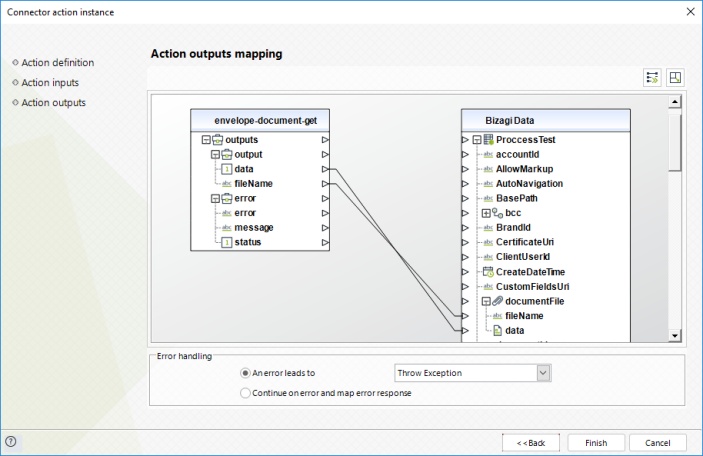Overview
The DocuSign connector for Bizagi is available for download at Bizagi Connectors Xchange.
Through this connector, you will be able to connect your Bizagi processes to a DocuSign account in order to use Electronic Signature services API.
For more information about this connector's capabilities, visit Bizagi Connectors Xchange.
Before you start
To test and use this connector, you will need:
1.Bizagi Studio previously installed.
2.The connector installed, either through the Connectors Xchange or via manual installation as outlined in the Installing and managing connectors article.
3.A registered account of DocuSign sandbox developer.

Configuring the connector
In order to configure the connector (i.e. its authentication parameters), follow the steps presented in the Configuration chapter at the Installing and Managing connectors article.
For this configuration, consider the following authentication parameters:
•subdomain: Subdomain assigned by DocuSign to your purchased account. For trial accounts, use demo.
•Authentication method: custom
•email: your Docusign’s account associated email.
•password: your Docusign’s account associated password.
•integratorKey: A valid Docusign’s integrator key (Previously generated in the step above).

Using the connector
This connector features seven available methods of DocuSign services: Request Recipient View, Send Template, Create Envelope, Create Sender View, Get Envelope, Get Envelope Document, and Get Envelope Document list.
To learn overall information on how/where to configure the use of a connector, refer to the Using connectors documentation.
When using the connector, make sure you consider the following details for each of the two available methods.
Request Recipient View

To configure its inputs, consider:
•envelopeId: Unique identifier for the envelope.
•recipientName: The recipient’s full name
•recipientEmail: The recipient’s email.
•clientUserId: A sender-defined value that identifies the embedded recipient and allows a signing URL to be generated for them. This parameter expects a numeric value.
•returnUrl: URL to which the recipient is redirected once the session finishes.
•recipientClientUserId: This parameter is optional. It is the same ID sent when the envelope is created. If this parameter is not sent, a sender view will be generated instead of a signer view.

To configure its outputs when getting started and testing, you may map the response URL from the output:

For more information about this method's use, refer to DocuSign’s official documentation.
Send Template
This method creates and sends an envelope with an embedded recipient.

To configure its inputs, consider:
•fileName: The name for the new document.
•fileContents: Contents of the new document.
•fileExtension: The extension of the new document
•documentId: This value is completely up to the client. The document ID number that the tab is placed on.
•recipientName: The recipient’s full name.
•recipientEmail: The recipient’s email.
•recipientId: Unique for the recipient. It is used to indicate which recipient is to sign the Document. This parameter expects a numeric value.
•recipentClientUserId: This parameter is optional. If specified, it identifies the signer with a unique ID. This parameter is then used in the Request Recipient View action.
•clientUserId: A sender-defined value that identifies the embedded recipient and allows a signing URL to be generated for them. This parameter expects a numeric value.
•xPosition: Indicates the horizontal offset of the tab on the page (DocuSign uses 72 DPI when determining position).
•yPosition: Indicates the vertical offset of the tab on the page (DocuSign uses 72 DPI when determining position).
•emailSubject: subject that Docusign sends in the email to the recipient.
•pageNumber: Specifies the page number on which the tab is located

To configure its outputs when getting started and testing, you may map:
•envelopeId: Unique identifier for the recently created envelope.
•status: Status for the recently created envelope.
•statusDateTime: Date and time when the envelope was created.
•URI: URL generated in order to access the recently created envelope.
For more information about this method's use, refer to DocuSign’s official documentation.
Create Envelope
This method creates and sends a new envelope

To configure its inputs, consider:
•documents: List of the documents to be signed in the envelope.
This way by mapping as well its inner documentBase64, documentId, fileExtension, and name elements, you can send the list of the documents to be signed.
For the fileName element, you may specify through text, a name for the file or map the fileName property from a Bizagi file attribute, and for documentBase64, map the data property from the same Bizagi file attribute so that an array of bytes (byte[]) is sent with the actual content of the file.
•emailSubject: Subject of the email used to send the envelope to the recipients.
•clientUserId: This parameter is optional. If specified, it identifies the signer with a unique ID. This parameter is then used in the Request Recipient View action.
•signers: List of the users who are going to receive the envelope and sign the documents.
This way and by mapping as well its inner email, name, recipientId, and note elements, you can send the list of the signers of the documents.
•accountid: Unique identifier of your DocuSign account.
•status: The status of the envelope. Set sent if the envelope will be immediately sent to the recipients or created if the envelope will be saved and sent later.
•cc: List of the users who are going to receive a carbon copy of the envelope. This way by mapping as well its inner email, name, recipientId, and note elements, you can send the list of the copied recipients.

To configure its outputs when getting started and testing, you may map:
•envelopeId: Unique identifier for the recently created envelope.
•status: Status for the recently created envelope.
•statusDateTime: Date and time when the envelope was created.
•uri: URL generated in order to access the recently created envelope.

For more information about this method's use, refer to DocuSign’s official documentation.
Create Sender View

To configure its inputs, consider:
•accountid: Unique identifier of the DocuSign account of the creator user of the envelope.
•envelopeId: Unique identifier of the envelope.
•returnUrl: URL generated in previous actions to access the envelope.

To configure its outputs when getting started and testing, you may map the returned url.

For more information about this method's use, refer to DocuSign’s official documentation.
Get Envelope
This method gets an envelope from its ID.

To configure its inputs, consider:
•accountid: Unique identifier of the DocuSign account of the creator user of the envelope.
•envelopeId: Unique identifier of the envelope.

To configure its outputs when getting started and testing, you may map:
•allowMarkup: specifies whether the markup is enabled (true) or not (false).
•autoNavigation: specifies whether the user is can redirect an envelope to another recipient (true) or not (false).
•brandId: Unique Identifier of the brand of the envelope
•certificateUri: URI of the endpoint used to retrieve the certificate information of the envelope.
•createdDateTime: Date when the envelope was created.
•customFieldsUri: URI of the endpoint used to retrieve the custom fields of the envelope.
•documentsCombinedUri: URI of the endpoint used to retrieve the combined documents of the envelope.
•documentsUri: URI of the endpoint used to retrieve the documents of the envelope.
•emailSubject: Subject of the email used to send the envelop to the recipients.
•enableWetSign: specifies whether the signer is able to print and sign the document (true) or not (false).
•envelopeId: Unique identifier of the envelope.
•envelopeIdStamping: specifies whether the Envelope ID Stamping is enabled (true) or not (false).
•envelopeUri: documentsUri: URI of the endpoint used to retrieve the envelopes.
•initialSentDateTime: Date when the envelope was sent.
•is21CFRPart11: specifies whether this module is enabled on the account (true) or not (false).
•isSignatureProviderEnvelope: specifies whether the envelope is Signature Provider (true) or not (false).
•lastModifiedDateTime: Date of the last update of the envelope.
•notificationUri: URI of the endpoint used to retrieve the notifications of the envelope.
•purgeState: Current purge state for the envelope.
•recipientsUri: URI of the endpoint used to retrieve the recipients.
•sentDateTime: Date when the envelope was sent.
•statusChangedDateTime: Date of the last status update of the envelope.
•status: Status of the envelope
•templatesUri: URI of the endpoint used to retrieve the templates.

For more information about this method's use, refer to DocuSign’s official documentation.
Get Envelope Document
This method gets a document from its ID, its envelope ID, and its account ID.

To configure its inputs, consider:
•accountid: Unique identifier of the DocuSign account of the creator user of the envelope.
•envelopeId: Unique identifier of the envelope.
•documentid: Unique identifier of the document.

To configure its outputs when getting started and testing, you may map:
•data: Map the attribute to the data property of a Bizagi file attribute so that the array of bytes (byte[]) has the content of the document.
•FileName: Map the attribute to the fileName property of a Bizagi file attribute.

For more information about this method's use, refer to DocuSign’s official documentation.
Get Envelope Document list
This method gets the document list with their authentication.

To configure its inputs, consider:
•accountid: Unique identifier of the DocuSign account of the creator user of the envelope.
•envelopeId: Unique identifier of the envelope.

To configure its outputs when getting started and testing, you may map:
•envelopeDocuments: Map this into a collection in your data model.
odisplay: the display and behavior properties of the document.
odocumentId: Unique identifier of the document.
oincludeInDownload: specifies whether this module is included in the combined document download (true) or not (false).
oname: Name of the document.
oorder: defines whether the document is sorted ascending or descending.
opages: number of pages of the document.
osignerMustAcknowledge: shows how the signer interacts with the document.
otype: type of the user (type_owner or type_participant).
oURI: URL created to access the document.

For more information about this method's use, refer to DocuSign’s official documentation.
Last Updated 10/7/2024 4:53:54 PM